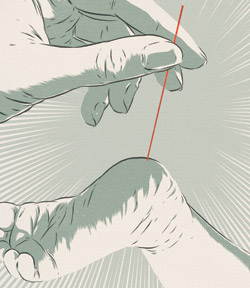SPRING 2013 CONTENTS
Home
Vital fluid
What we know about blood
Roll up your sleeve
There's still no substitute for blood
Life of blood
A guide to the cells coursing through your veins
Blood quest
The battle to protect transfusions from HIV
Against the flow
What's behind the decline in Blood transfusions?
Blood, sweat and fears
A common phobia's odd pathophysiology

DOWNLOAD PRINTABLE
ISSUE (PDF)


Heel sticksWill tests for newborns go big?
It’s a ritual of modern birth: Soon after delivery, blood is collected from new babies’ heels, blotted onto filter paper and tested for life-threatening diseases. Newborn blood-spot screening began in the United States in 1966, with surveillance for a single disease, and has expanded enormously. Thirty-one disorders are now recommended by the federal government’s screening committee, and many states, including California, screen for even more. But that expansion is tiny compared to what’s on the horizon.
Illustration by Matthew Woodson

Within the next decade, whole-genome sequencing, which records every letter of the genetic code, will likely become sufficiently fast, accurate and cheap to compete with current screening methods. Today, newborn screening relies largely on mass spectroscopy, a technology that measures specific metabolic products in the blood. It’s a needle-in-the-haystack approach that looks for markers of specific diseases. Whole-genome sequencing, in contrast, could test the whole haystack. The idea carries a tantalizing possibility of catching or predicting far more diseases than current screening methods, and, in a best-case scenario, alleviating much human suffering.
But screening newborns’ genomes would raise a bushel of ethical questions, says Stanford bioethics expert Hank Greely, JD, a law professor and director of the Center for Law and the Biosciences. Already, a few of the screening tests performed in some states give ambiguous results, leaving parents wondering if their children are actually sick.
“If we move to whole-genome sequencing, we’ll be going down this road at supersonic speeds, and it’s a winding road,” Greely says. “But there are strong forces in favor of new technology. It will be hard to resist the lure of getting the whole genome for the same price as testing for 30 to 50 diseases.”
The biggest ethical questions revolve around interpreting the data. Individual genetic variations, coupled with our still-sketchy understanding of the human genome, mean each screen would produce thousands of puzzling data points. How much of that information would families need? How often would it be re-interpreted in light of new science? How would we ensure it wasn’t used to “treat” infants for genetic variations that would never lead to illness? No one knows.
Privacy concerns also loom: How would genetic data, once collected, be secured? What if the data revealed uncomfortable surprises, such as genetic-disease predispositions among parents or siblings, or awkward revelations about the identity of an infant’s father?
Some newborn screening experts are skeptical about whether whole-genome screening will be adopted, even as the technology improves.
“We’re looking to detect known disease,” says Fred Lorey, PhD, chief of program and policy for the Genetic Disease Screening Program at the California Department of Public Health and a member of the federal committee that evaluates diseases for screening. The committee recently rejected single-disease tests that share the ambiguities whole-genome screens would produce, Lorey says. The proposed tests poorly predicted which children would get sick, or the diseases lacked effective treatments. “I don’t see newborn screening, at least in the near future, ever going to tests that show mere risk factors,” Lorey says.
Still, Greely’s not relaxing, suggesting that newborn screening experts start recommending how to address the ethical challenges. He concludes, “I think that if price comes down and accuracy goes up, political and social dynamics will make it impossible for us to turn this down.”
— Erin Digitale

